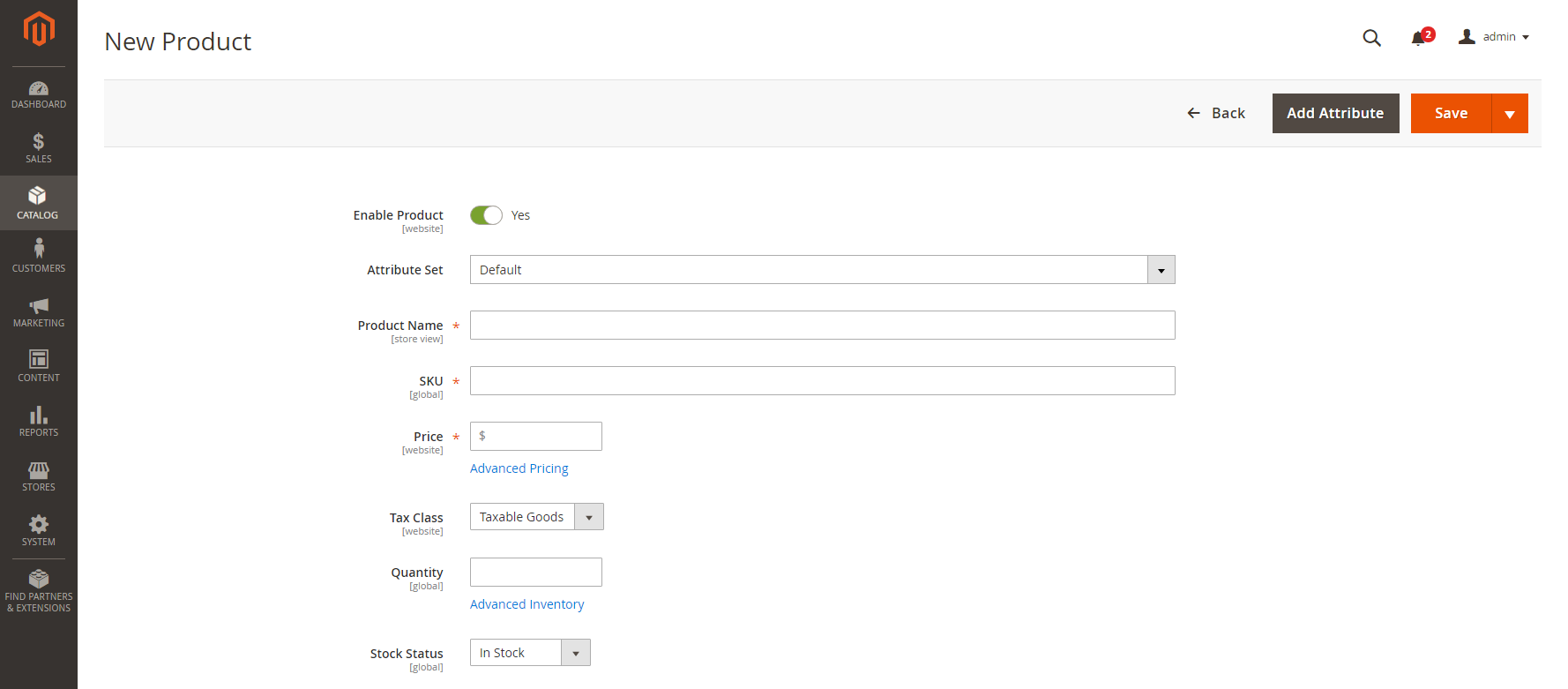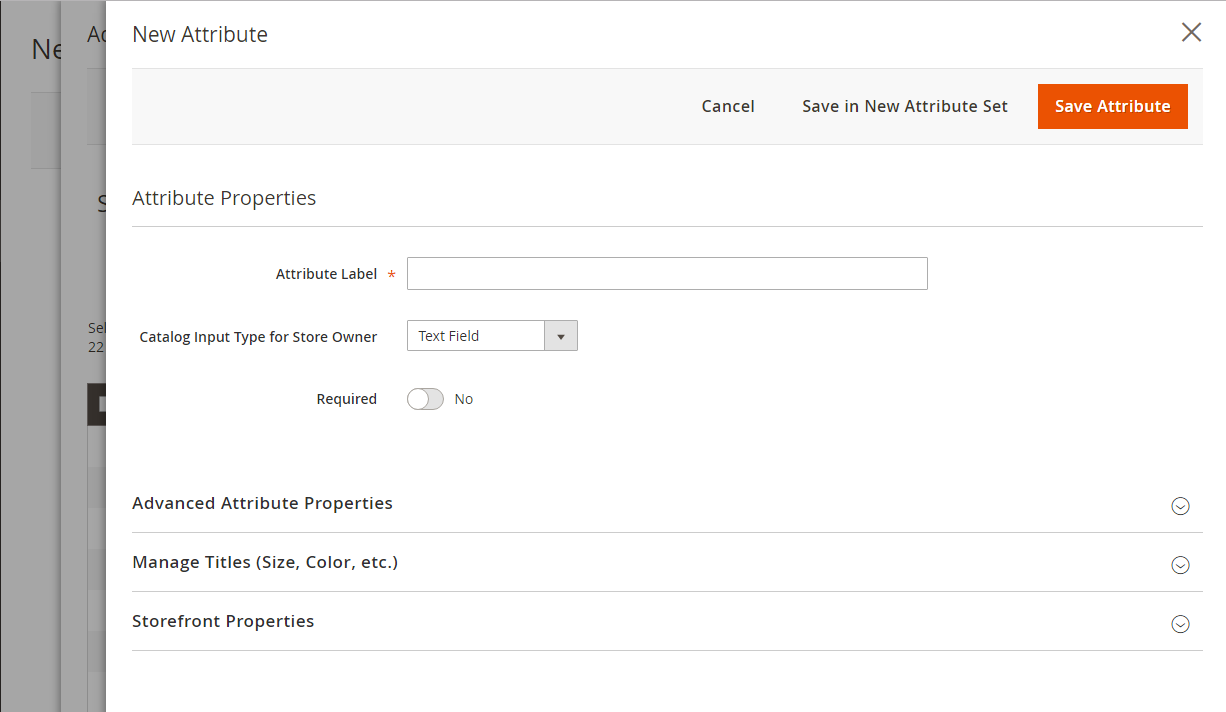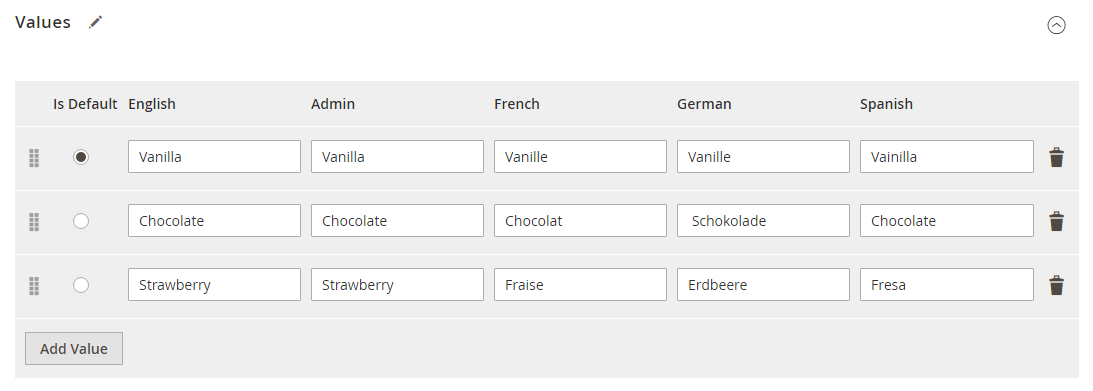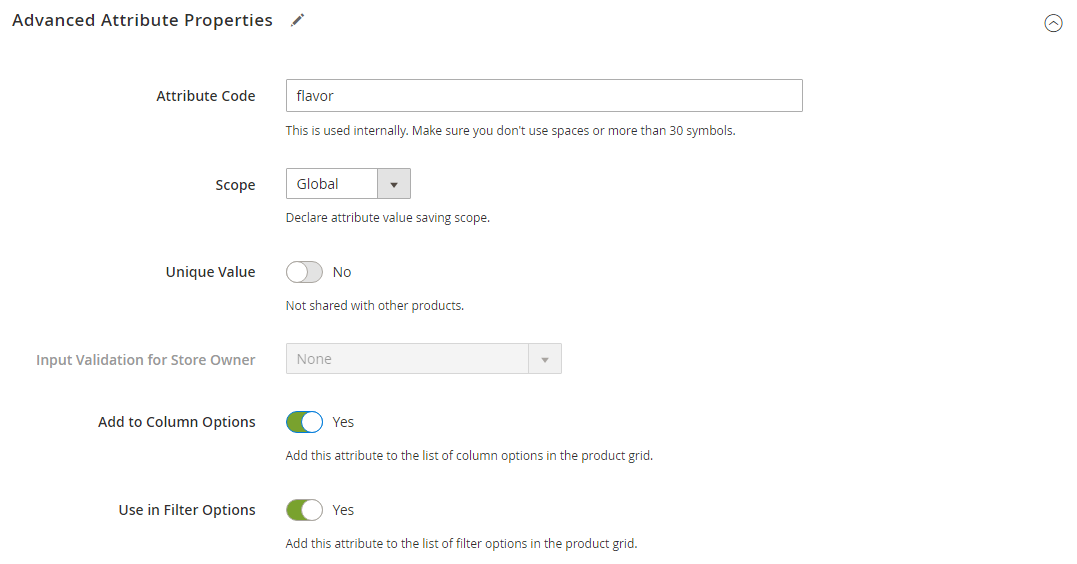Adding an Attribute to a Product
Although attributes are managed primarily from the Stores menu, you can also add new attributes on the fly while working on a product. You can choose from the list of existing attributes or create a new attribute. The new attribute is added to the attribute set upon which the product is based.
 Add Attribute
Add Attribute
Step 1: Add a product attribute
-
Open the product in edit mode.
-
In the upper-right corner, click Add Attribute.
 New Attribute
New Attribute -
To add an existing attribute to the product, use the filter controls to find the attribute in the grid and do the following:
-
Select the checkbox in the first column of each attribute to be added.
-
Click Add Selected.
-
-
To define a new attribute, click Create New Attribute and complete the following steps.
Step 2: Describe the basic properties
 Attribute Properties
Attribute Properties
-
Under Attribute Properties, enter an Attribute Label to identify the attribute.
-
Set Catalog Input Type for Store Owner to the type of input control to be used for data entry.
If the attribute is used for a configurable product, choose
Dropdown. Then, set Required toYes. -
For
DropdownandMultiple Selectinput types, do the following:-
Under Values, click Add Value.
-
Enter the first value that you want to appear in the list.
You can enter one value for the Admin and a translation of the value for each store view. If you have only one store view, you can enter only the Admin value, and it will be used for the storefront as well.
-
Click Add Value and repeat the previous step for each option that you want to include in the list.
-
Select Is Default to use the option as the default value.
 Values
Values -
-
If you want to require the customer to choose an option before the product can be purchased, set Required to
Yes.
Step 3: Describe the advanced properties (optional)
 Advanced Attribute Properties
Advanced Attribute Properties
-
Enter a unique Attribute Code in lowercase characters and without spaces.
-
Set Scope to indicate where in your store hierarchy the attribute can be used.
If the attribute is used for a configurable product, choose
Global. -
If this attribute applies only to this product, set Unique Value to
Yes. -
To run a validity test of any data entered into a text field, set Input Validation for Store Owner to the type of data that the field should contain.
This field is not available for input types with values that are selected. Input validation can be used for any of the following:
- Decimal Number
- Integer Number
- URL
- Letters
- Letters (a-z, A-Z) or Numbers (0-9)
 Input Validation
Input Validation -
If you want to be able to include the attribute as a column in the Products grid, set Add to Column Options to
Yes. -
If you want to be able to filter the Products grid by this column, set Use in Filter Options to
Yes.
Step 4: Enter the field label
-
Expand
 the Manage titles section.
the Manage titles section. -
Enter a Title to be used as a label for the field.
If your store is available in different languages, you can enter a translated title for each view.
 Manage Titles
Manage Titles
Step 5: Describe the storefront properties
-
Expand
 the Storefront Properties section.
the Storefront Properties section. Storefront Properties
Storefront Properties -
To make the attribute available for search, set Use in Search to
Yes. -
To include the attribute in Product Compare, set Comparable on Storefront to
Yes. -
To include dropdown, multiple select, or price attributes in layered navigation, set Use in Search Results Layered Navigation to one of the following:
Filterable (with results) Layered navigation includes only those filters for which matching products can be found. Any attribute value that already applies to all products shown in the list does not appear as an available filter. Attribute values with a count of zero (0) product matches are also omitted from the list of available filters.
The filtered list of products includes only those that match the filter. The products list is updated only if the selected filter(s) change what is currently shown.Filterable (no results) Layered navigation includes filters for all available attribute values and their product counts, including those with zero (0) product matches. If the attribute value is a swatch, the value appears as a filter, but is crossed out. -
To use in layered navigation on search results pages, set Use in Search Results Navigation to
Yesand enter a number in the Position field.The position number indicates the relative position of the attribute within the layered navigation block.
-
To use the attribute in price rules, set Use for Promo Rule Conditions to
Yes. -
To allow the text to be formatted with HTML, set Allow HTML Tags on Storefront to
Yes.This setting makes the WYSIWYG editor available when editing the field.
-
To include the attribute on the product page, set Visible on Catalog Pages on Storefront to
Yes. -
Complete the following settings as supported by your theme:
-
To include the attribute in product listings, set Used in Product Listing to
Yes. -
To use attribute as a sort parameter for product listings, set Used for Sorting in Product Listing to
Yes.
-
-
When complete, click Save Attribute.